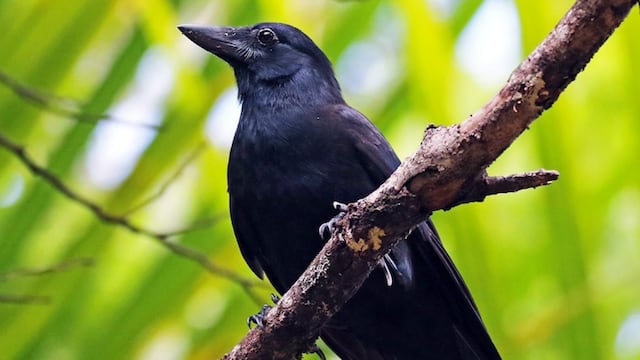The New Caledonian crow is a bird capable of creating rudimentary tools and even improving them, sharing its discoveries and technological progress with its peers so that the species thrives.

The smartest bird in the world can make tools and is as intelligent as some primates and small children
The animal kingdom is full of fascinating creatures. Although birds have historically been thought to have limited intelligence due to the size of their brains, recent research is rapidly disproving this belief. Advances in bird studies have established that the New Caledonian crow (Corvus moneduloides) has an intelligence comparable to that of young children, demonstrating abilities only seen in humans and some primate species, such as tool making and use, and long-term planning and thinking.
The New Caledonian crow is the most intelligent bird in the world: it can solve complex problems and even make, use, and improve tools.
The New Caledonian crow (Corvus moneduloides) has challenged everything we thought we knew about animal intelligence. This species, native to the islands of New Caledonia in the South Pacific, has demonstrated an astonishing ability to solve complex problems that even some primates struggle with. Over the past few decades, researchers have documented the astonishing behavior of these crows, which have shown they possess advanced cognitive abilities that rival those of some of the most intelligent species on the planet, including humans. From their ability to recognize patterns to their capacity to anticipate situations—demonstrating a deep understanding of cause-and-effect relationships in their environment—these birds are rewriting the history of the animal kingdom.
In a famous experiment documented in the video below, a crow named 007 managed to solve a complex, multi-step puzzle that required him to use tools to obtain other tools that would be appropriate for reaching the final stage, which allowed him to obtain food. It’s a puzzle that wouldn’t be out of place in a classic Resident Evil game, as these puzzles also required following a logical sequence.
One of the most impressive characteristics of New Caledonian crows is their ability to make and use tools. Unlike many other birds, which simply obtain their food directly from their environment, these crows are capable of carving complex tools from sticks and leaves, which they then use to reach insects and larvae in hard-to-reach places like holes. Their greatest achievement is that they can even make hooks, making them the only animal species, other than humans, capable of crafting such a complex tool.
Most surprisingly, they not only use pre-existing tools but also have the ability to update and optimize them, which requires a deep understanding of their environment and an advanced level of planning. In studies conducted by scientists, crows have shown they are capable of “improving” their own tools to make them more effective. This requires not only an understanding of how the tool should be used, but also the ability to foresee how changes to the tool itself will affect its performance for the intended task. This revolutionary discovery may even imply that these animals have their own “culture,” as they are highly social beings who share knowledge of these rudimentary “technological advances” with each other, even giving rise to distinct “local traditions” and diverse “manufacturing techniques.”
The New Caledonian crows’ ability to solve complex problems using tools implies an astonishing ability for long-term planning, which was previously considered a skill exclusively found in humans or advanced primates. These crows not only solve immediate problems but can also anticipate future situations and make strategic decisions based on foresight, demonstrating a degree of abstract thinking. For example, 007’s experiment required the animal to correctly identify the purpose of each of the objects it interacted with. While a short stick was not useful for directly reaching the food—the ultimate reward—the animal understood that it did allow it to obtain several small stones, which it then used as a counterweight that released a longer stick, which ultimately allowed it to reach the food and pull it within reach. In other words: the animal understood perfectly well that it had objects within its reach that, while not directly enabling it to obtain food, could be part of a series of concrete steps that would allow it to obtain its longed-for feast.
In other experiments and observations documented in the book “The Ingenuity of Birds” (Jennifer Ackerman, 2016), numerous instances have been reported in which these crows have stored tools for future use, and even traveled with them, demonstrating a highly sophisticated understanding of time. This level of planning reveals that they possess complex minds capable of thinking beyond immediate solutions, allowing them to also reflect on the medium- and long-term consequences of their actions. These animals also learn “on the fly” at an accelerated pace, as demonstrated by this video in which Yellow the crow can be seen learning to place objects in containers of water so that floating food remains within reach:
There are still many clues to be revealed in this fascinating field, but for now, research on the high intelligence of these animals, considered comparable to that of young children between four and eight years old, points in two directions. On the one hand, it may be that the New Caledonian crows’ lack of natural predators provides them with an advanced environment in which they have an extended childhood, allowing them to play and experiment with few worries, which favors their cognitive development. On the other hand, there is also speculation that the size of their brain does not influence their intelligence, but rather that the determining factor is their high neuronal density and their “advanced brain connections,” which would explain their great “computational power.” Small brains, yes, but surprisingly efficient.
These findings point to convergent evolution in which, although birds diverged from mammals hundreds of millions of years ago, natural selection has meant that, generation after generation, these animals have acquired innate abilities more typical of primates and even humans, helping them use their considerable ingenuity to thrive and perpetuate their species.
Related stories
Get your game on! Whether you’re into NFL touchdowns, NBA buzzer-beaters, world-class soccer goals, or MLB home runs, our app has it all.
Dive into live coverage, expert insights, breaking news, exclusive videos, and more – plus, stay updated on the latest in current affairs and entertainment. Download now for all-access coverage, right at your fingertips – anytime, anywhere.


Complete your personal details to comment